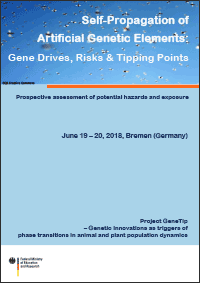Self-Propagation of Artificial Genetic Elements: Gene Drives, Risks & Tipping Points
Prospective assessment of potential hazards and exposure
June 19 – 20, 2018, Bremen (Germany)
At present, attempts are being made on several fronts to release genetically engineered organisms into the environment – the aim is to introduce artificial genetic information into native populations. The main focus is on insects carrying a so-called “gene drive”. In natural populations, gene drives are inherited at a higher frequency than is the case in classic patterns of inheritance. Target species under discussion include flies, rats and various plant species. In our project, these technologies are summarised as “self-propagating artificial genetic elements” (SPAGE).
According to EU regulation, the precautionary principle must be applied if genetically engineered organisms are to be released into the environment. Therefore, causes for concern, potential hazards and exposure potential associated with the release of such organisms all need to be identified. Within the project, special focus is placed on potential tipping points within affected systems. Our aim is to assess and compare expected consequences of such releases into (agro-) ecosystems and to estimate associated socioeconomic effects. For this reason results of a GeneTip-case study on olive flies were presented at our conference.
In addition, we presented some requirements in regard to societal and legal frameworks as well as for precaution-oriented technology design, including the possible need for action by regulatory authorities and policy makers.
At the conference we discussed the following questions:
- How powerful and reliable are current SPAGE technologies?
- How vulnerable are affected systems and how can relevant tipping points be identified by prospective risk assessment?
- How can these technologies be regulated with regard to the precautionary principle?
- Can risks going along with self-enforcing dynamic processes (tipping points) be identified?
Most of the presentations are published below:
- Welcome & Introduction: Prospective technology assessment // Arnim von Gleich (University of Bremen)
- Gene Drives touching tipping points // Broder Breckling (University of Vechta) and Arnim von Gleich (University of Bremen)
- Advantages of SPAGE in agriculture to combat pest insects // Luke Alphey (University of Oxford)
- Differences of Current GMO to Gene Drive Organisms – Challenges for Risk Assessment / Samson Simon (Federal Agency for Nature Conservation, Bonn)
- A wider ethical perspective / Uta Eser (Büro für Umweltethik Tübingen)
- Modelling of Gene Drives to identify bottlenecks and tipping points // Merle Preu (University of Vechta), Broder Breckling (University of Vechta), Johannes Frieß (University of Bremen)
- Technology characterisation of Gene Drives and potential applications // Bernd Giese (University of Natural Resources and Life Sciences, Vienna)
- Emmanouil Kabourakis (Institute of Oliviculture, Subtropical Plants and Viticulture (NAGREF), Crete) // SPAGE in agriculture to combat pest insects – the perspective of organic agriculture
- Potential impact of GM-Insects on organic farming // R. Guy Reeves (Max Planck Institute for Evolutionary Biology, Plön)
- Reliability of CRISPR-Cas // Katharina Kawall (Fachstelle Gentechnik und Umwelt, München)
- Risk assessment, risk management and regulation // Christoph Then (Testbiotech, Munich)

